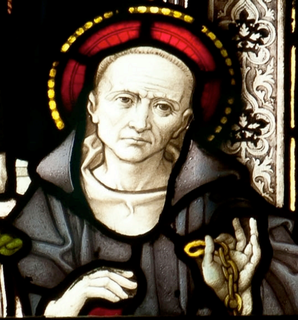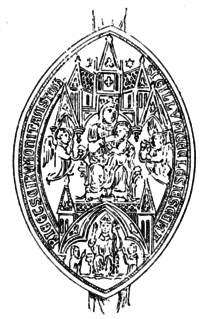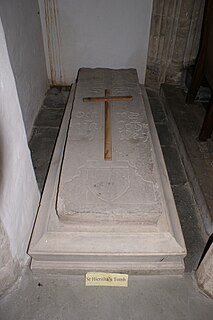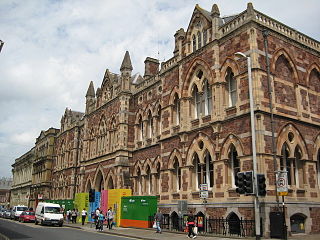External links
- St.Brannock's church web site Retrieved May 2012
- Brief biography of St Brannock Retrieved May 2012
Saint Brannoc | |
|---|---|
| Born | 6th century supposedly Wales |
| Died | Braunton in North Devon |
| Venerated in | Anglican Communion, the Orthodox Church and Roman Catholicism |
| Major shrine | Braunton in North Devon (destroyed) |
| Feast | 26 June or 7 January. |
Brannoc of Braunton or Saint Brannock was a Christian saint associated with the village of Braunton in the English county of Devon. His feast is 7 January.
The history of St Brannoc is confused – some sources conflate him with Saint Brynach, however Exeter Cathedral celebrates the feast of Brynach on 7 April and that of Brannoc on 7 January so it is unlikely that they are the same saint. [1] [2] In contrast, Braunton celebrates St Brannock's Day on the 26 June.[ citation needed ]
Brannock migrated from South Wales to establish a monastery at Braunton in the 6th century. [3] [4] Braunton church was dedicated to him from at least 854 and in the Middle Ages it was believed that he was buried in the church [5] with both William of Worcester and Leland stating that he was buried there. [6] Tradition states that he first built his church on a hill overlooking Braunton, but it collapsed. In a dream he was told to look for a sow and seven piglets for the site to build his new church. This story is commemorated in one of the stained glass windows and in a roof boss of St Brannock's Church, Braunton. [1]
Ælfheah, more commonly known today as Alphege, was an Anglo-Saxon Bishop of Winchester, later Archbishop of Canterbury. He became an anchorite before being elected abbot of Bath Abbey. His reputation for piety and sanctity led to his promotion to the episcopate and, eventually, to his becoming archbishop. Ælfheah furthered the cult of Dunstan and also encouraged learning. He was captured by Viking raiders in 1011 during the siege of Canterbury and killed by them the following year after refusing to allow himself to be ransomed. Ælfheah was canonised as a saint in 1078. Thomas Becket, a later Archbishop of Canterbury, prayed to him just before his own murder in Canterbury Cathedral in 1170.

Devon is a county in South West England, reaching from the Bristol Channel in the north to the English Channel in the south. It is bounded by Cornwall to the west, Somerset to the north-east and Dorset to the east. The county includes the districts of East Devon, Mid Devon, North Devon, South Hams, Teignbridge, Torridge and West Devon and the city of Exeter, its county town. The other two large urban areas Plymouth and Torbay are each geographically part of Devon, but are administered as unitary authorities. Combined as a ceremonial county, Devon's area is 6,707 km2 and its population is about 1.2 million.

Saint Piran or Pyran, died c. 480, was a 5th-century Cornish abbot and saint, of Irish origin. He is the patron saint of tin-miners, and is also generally regarded as the patron saint of Cornwall, although Saint Michael and Saint Petroc also have some claim to this title.

Saint Petroc or Petrock was a British prince and Christian saint.

Braunton is a large English village, civil parish, ecclesiastical parish and former manor in Devon. The village is situated 5 miles (8 km) west of Barnstaple. It is one of the largest villages in Devon with a population at the 2021 census of 10,217 people. There are two electoral wards. Their joint population at the above census was 8,218. Within the parish is the fertile, low-lying Braunton Great Field, which adjoins the undulating Braunton Burrows, the Core Area in North Devon Biosphere Reserve, the largest psammosere in England. It confronts the Atlantic Ocean at the west of the parish at the large beach of Saunton Sands, one of the South West's international-standard surfing beaches.

The Flag of Devon, properly St Petroc's Cross, is the flag of the English county of Devon. It is dedicated to Saint Petroc, a local saint with numerous dedications throughout Devon. It is notable for its creation through two web-based polls.

June 25 - Eastern Orthodox Church calendar - June 27

The Bishop of Exeter is the ordinary of the Church of England Diocese of Exeter in the Province of Canterbury. Since 30 April 2014 the ordinary has been Robert Atwell.

January 6 - Eastern Orthodox liturgical calendar - January 8
Ælfric of Abingdon was a late 10th-century Archbishop of Canterbury. He previously held the offices of abbot of St Albans Abbey and Bishop of Ramsbury, as well as likely being the abbot of Abingdon Abbey. After his election to Canterbury, he continued to hold the bishopric of Ramsbury along with the archbishopric of Canterbury until his death in 1005. Ælfric may have altered the composition of Canterbury's cathedral chapter by changing the clergy serving in the cathedral from secular clergy to monks. In his will he left a ship to King Æthelred II of England as well as more ships to other legatees.

Tavistock Abbey, also known as the Abbey of Saint Mary and Saint Rumon, is a ruined Benedictine abbey in Tavistock, Devon. Nothing remains of the abbey except the refectory, two gateways and a porch. The abbey church, dedicated to Our Lady and St Rumon, was destroyed by Danish raiders in 997 and rebuilt under Lyfing, the second abbot. The church was further rebuilt in 1285 and the greater part of the abbey between 1457 and 1458.

Urith was a Christian woman from the Westcountry of Great Britain who was alleged to have been martyred in the 8th century, and subsequently revered as a saint. The name is still common in the English county of Devon. Her feast day is 8 July and her shrine is located in the North Devon village of Chittlehampton. Her name is also known in Latin as Hieritha and occasionally corrupted to Erth.

Sidwell was a virgin saint from the English county of Devon, She is the patron saint of Exeter and sister to Saint Juthwara.
Branwalator or Breward, also referred to as Branwalader, was a British saint whose relics lay at Milton Abbas in Dorset and Branscombe in Devon. Believed to come from Brittany, he also gives his name to the parish of Saint Brélade, Jersey. "Brelade" is a corruption of "Branwalader". He is also known as Breward or Branuvelladurus or Brélade and Broladre in French.
Anselm was a medieval bishop of London whose election was quashed by Pope Innocent II. He was a monk of Chiusa, abbot of Saint Saba in Rome, papal legate to England, and abbot of Bury St Edmunds.

Beorhthelm is an Anglo-Saxon saint about whom the only evidence is legendary. He is said to have had a hermitage on the island of Bethnei, which later became the town of Stafford. Later he went to a more hilly area, possibly near Ilam, where he died. Beorhthelm (Bertram) of Stafford is venerated as a saint in the Eastern Orthodox Church and Roman Catholic Church, with a feast day on 10 August.

Richard the Pilgrim or Richard of Wessex was the father of the West Saxon saints Willibald, Winnibald, and Walpurga. He led his family on a pilgrimage to the Holy Land but died en route in Lucca, where he was buried in the church of Saint Fridianus.

John Hayward (1807–1891) was a Gothic Revival architect based in Exeter, Devon, who gained the reputation as "the senior architect in the west of England".

St Brannock's Church is a medieval Church of England church in Braunton, Devon, England. According to legend it was founded by Saint Brannock, a 6th-century Christian saint. It became a Grade I listed building on 25 February 1965.